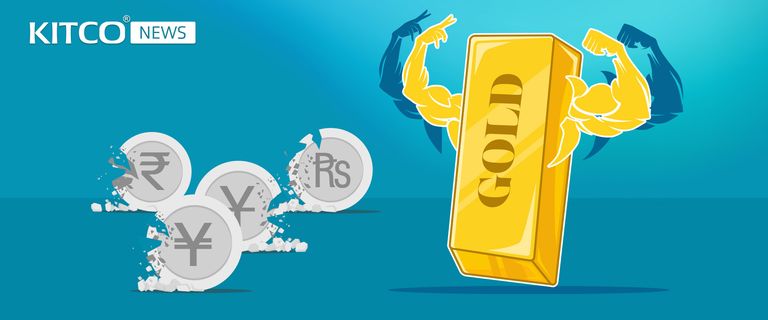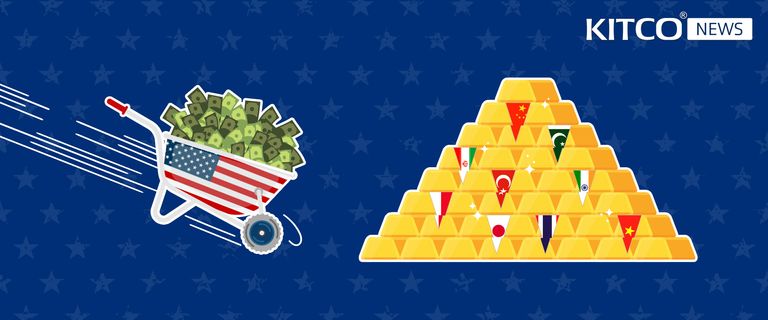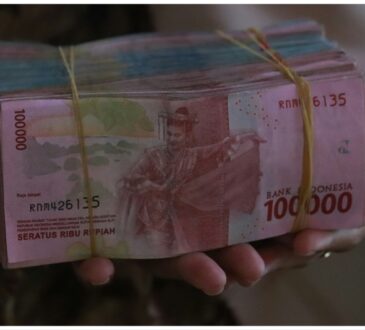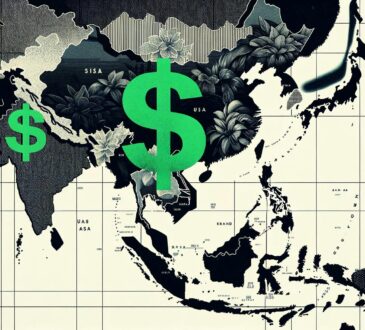
(Kitco News) – Gold set new all-time highs in nearly all of the world’s currencies in 2023, and the yellow metal has continued to peak on many price charts in the new year. Even with its recent pullback as central bankers have reined in the market’s rate cut expectations, gold prices remain near ATHs, holding above $2,000 per ounce in U.S. dollar terms.
But new high-water marks for the yellow metal in any other currency, even all the other currencies at once, can’t seem to add up to a catalyst for a broader market move. While it’s true that gold and other commodities are denominated in USD, and that the greenback, even under duress, remains unchallenged as the world’s reserve currency, it’s not the only currency that matters. Or is it?
“In a rational world, those charts would be more important,” said Adam Button, head of currency strategy at Forexlive.com. “The U. S. economy is, what, 25 percent of global GDP? And then the U.S. dollar might be another 5-10 percent of that, which means the vast majority of commerce and value is still in non-U.S. dollar currencies, and that should be indicative of the value of gold.”
Button noted that in the developed world economies, and in the United States in particular, “investor interest is dismal” despite new record prices continually being set in other national currencies. “The reality of financial markets is that they’re U.S.-dollar driven, and no matter how well you perform in domestic currencies, it doesn’t seem to matter until you’ve done it in dollar terms.”
Button sees this as an inefficiency in markets. “Does someone in Japan look at gold in yen and FOMO because it’s breaking out? They see that more as yen weakness rather than gold strength,” he said. “You could say the same argument about the U. S. dollar. We’re probably at the peak of the cycle for the U. S. dollar, and two years from now, if the dollar is significantly lower, will we see that as dollar weakness or gold strength? I think it’s probably seen as gold strength.”
Japan is an interesting illustration of the flipside to this equation. When gold does hit all-time highs in U.S. dollar terms, the developed world’s investors in North America and much of Europe, including individuals and boutique trading houses as well as massive hedge funds and gold ETFs, do indeed react: they sell the gold and pocket the profits. But Japan and the developing economies do not. Even when gold is the most expensive it’s ever been, even when they know the dollar-denominated world will take their profits, they don’t, and instead continue to buy.
What’s going on here? An ounce of gold is an ounce of gold anywhere in the world, but even if at a quantitative level the price is fairly consistent (with the obvious exception of government-controlled gold markets like China’s), the value it represents seems to be qualitatively different outside of the United States and Western Europe.
“There will always be a demand for alternative, hard assets,” Button said. “Gold has been fulfilling that role, that instability role, that uncertainty premium, that ‘put something in your pocket and leave everything’ role.”
As the emerging world grows wealthier, its populations have a propensity to buy gold that might not exist in a place like the United States and Canada where there’s the presumption of stability of governments, markets, banks, and other institutions, and where property rights are seen as immutable.
“Look where we are in the rate cycle,” Button said. “It hasn’t been a great time for emerging markets. China’s just a vortex that’s sucking everything down right now. But where are we in that cycle? Obviously, it can get worse. But I think it’s going to get better as we cut rates.”
“There’s a zillion dollars in short-term T-bills that, as rates get cut, look elsewhere,” Button noted. “You start to see [emerging market] growth, and then you have these rising currencies, maybe gold falling in local currency terms, but probably rising in U.S. dollar terms.”
“Maybe that just ends up in a grind up to $2,500 or something like that, which I think everybody would be happy with.”
Gold’s value depends on where you’re standing
When gold is assessed from the perspective of the North American and European investor class, it’s measured apples-to-apples with other assets, and the essential question is which one will perform best. Investors who believe themselves safely ensconced in ‘Fortress USD’ might not value gold’s low volatility and wealth-preservation attributes. The dollar and the U.S.-led financial system is their security, and they’ll move those dollars in and out of other assets based on their potential performance. Their economic world is stable, and greed is the primary driver of their behavior: How do I make as much as possible?

But viewed through the eyes of most other countries’ investors, even the most trusted and mature assets like stocks, bonds, real estate, even sovereign debt look like apples, while gold is an orange. Only the yellow metal has a track record of price stability in good times and bad. Gold won’t go into freefall when demand for your country’s hottest export declines, or your domestic real estate market collapses. Gold will appreciate against your country’s inflationary currency because it appreciates even against the almighty dollar itself.
While greed is very much a part of the equation, these are fundamentally fear-driven investors: How do I protect myself from losing everything?
“Commodities have done terribly, except for gold and maybe aside from uranium,” Button said. “It’s telling that there is an underlying bid there. I think if we look out the next 50 years, a lot of the buying of gold is going to be in emerging markets. I think we’d all love to see the American investor class pile in like 2004 to 2008 again, but maybe that was a once-in-a-lifetime thing. And the rest of it is just instability. If you’re in Taiwan, or China, or any place where there might be instability, in Latin America, those places should see meaningful inflows indefinitely.”
Viewed through the bifurcated lens of USD (and Euro, to a degree) vs. everyone else, the investment prospects for gold look very strong: Investment from developed economies flows into gold when it looks like an appreciating asset, and especially when the U.S. dollar dips, boosting market sentiment and pushing prices higher. When prices top out in USD terms, they sell to emerging market investors who were buying all along, and whose price-insensitive demand creates a concrete floor to support gold at its newly elevated level.
“It’s about wealth preservation,” Button said. “If you’re preserving wealth in any of those places, sure, you could buy Bitcoin. But you’re preserving wealth, you don’t want something with 25 percent volatility. If you have $10 million in India, you can allocate a little bit to that, but you really just need something to preserve your wealth. The stability of gold is key.”
“So maybe the question is, the people who’ve been buying gold in the last year, is it the strong hands buying, or is it the fast money buying? I would wager that it’s the strong hands that have been accumulating gold,” he said. “Even looking at GLD over the last year, looking at trading volumes, it just hasn’t been great, which again points to it being physical buyers, real buyers, not financial, short-term buying.”
Governments want gold as badly as their citizens
The other big split in the gold market has been playing out at the government level, and it mirrors the private investment dynamic to a degree: emerging economies with weaker currencies such as China and Turkey do contribute steady and strategic demand even as prices hold at historically high levels. The difference is that at the national level, many of the more developed nations are doing the same, albeit for different reasons.
“The Hungarians, the Czech Republic, in Poland, there is a division in the European Union, it goes back to the 50s, 60s, 70s, 80s, 90s. We still have that East-West division,” said Darin Newsom, Senior Market Analyst at Barchart.com.
Newsom said that this divide within Europe is growing larger as Russia reasserts itself, and it’s exerting both military and financial pressure on member nations. “Many of those countries in the EU are going to see, not only could the Euro be at risk, but other individual countries’ currencies are at risk of devaluation. And if so, they’ve got to have it backed by gold. We never know what Russia’s next move is going to be, and they’re still the big dog in Eastern Europe.”
Newsom said the impacts of Russian influence are forcing realignments in the region as countries must pick a side. “You’ve got Hungary following Turkey to a certain degree, you’ve got these other countries that are going to continue to go along with whatever Russia says,” he said. “And then on the Western side, we’ve got Poland and some of the others, when they see what’s been going on in Ukraine, there’s always this threat, that Russia’s going to make a next move, particularly if the U.S. elections don’t go as Russia wants right now.”
“We’ll have to see how that plays out, but if it comes out bad for Russia in the European election, the U.S. election, then I think we see more invasions, and I think we see this Ukraine conflict spread,” Newsom said. “So you’re seeing those countries buying up more gold.”
He sees nations responding to global threats and economic uncertainties in the same way as their populations, with gold purchases. “Countries are going to continue to want to have a set amount of their assets in something physical like gold, because nobody knows how all of this is going to turn out,” Newsom said. “I’m not saying the U.S. dollar is going to go the route of the Argentine peso, nothing ever gets quite as terrible as that currency. But I do think there’s a possibility for some wild swings in currencies over this next year.”
Security, inflation and currency depreciation still drive demand
While the Russia-Ukraine war is helping drive sovereign gold purchases in Eastern Europe, currency devaluation remains a major concern for countries across the globe, and gold is one way to stop the bleeding.
“They’re creating their own gold standards,” said Sean Lusk, co-director of commercial hedging at Walsh Trading. “That’s what I think.”

Lusk said that many nations have watched inflation spiral out of control since the pandemic, and the central banks of many countries are buying gold to backstop the value of their currencies, which in turn has distorted the gold market and created a very firm floor for prices.
“If you see your own central bank buying and hoarding, coming into every dip in the market and buying, then what are you doing? You’re creating an underlying put in the market,” he said. “You’re creating your own gold standard that is an offset to your own fiat currency. You don’t know where the value is going to be, so you have no confidence in it. Certainly, we’ve seen that in Turkey, we’ve seen that in Russia, we’ve seen that in other parts of Eastern Europe and throughout the world.”
Lusk pointed out that in Argentina today, the next best thing to gold is a bushel of soybeans, because they are now viewed as a durable good. “Their currency is worthless, and the government’s willing to pay them more than what the underlying bushel’s really worth, just to get them to move it so the government can collect taxes on it,” he said. “That’s how insane it is.”
And this underlying bid for gold is also present in many countries even when inflation isn’t the all-consuming economic issue. Lusk said that the largest and most stable markets for gold consumption have long-standing cultural and historical factors that also contribute to this permanent bid underneath the price of the precious metal as their populations become wealthier.
“In India, for instance, they were the world’s number one consumer, now they’re number two,” he said. “China’s been doing it, they started this 20 years ago. You have the Chinese and Indians coming in on dips and buying, whether it be their central banks or their people, or their jewelers, or the ‘haves’ in those economies.”
“Even the ‘have-nots’, they come and buy cards with little specks of gold in them. It’s like a microdose of gold, but they still buy it.”
The divided market will come together eventually
This runaway global inflation, massive political uncertainty, and widening military conflicts are coming together to create a unique set of conditions which support demand for gold.
“It comes down to an actual physical commodity, which is storable, which can hold forever,” Newsom said, adding that gold’s limited supply is a big part of its appeal. “Yes, there’s still mining going on, but you don’t see huge changes in supply and demand.”
Newsom said that with all of the wars and uncertainty in the world, including the many upcoming elections this year, he expects to see more buyers than sellers in the market. “We’ve just seen the Argentine elections, we’ve got U.S. elections coming up,” he said. “I think actual physical investors are going to want to continue to hold their gold.”
Newsom said that this fundamental and medium-term instability in currencies will support interest in physical gold.
“I think it’s going to keep it strong,” he said. “Not necessarily gold futures, they’re going to sway back and forth, but fundamentals win in the end. If you see good demand for the actual, physical product and futures markets moving all over, money’s coming in and out, eventually, the futures market is going to look over and see the actual, physical, cash gold market isn’t moving that much and you’re getting this divergence between other investment areas and actual, physical gold. Then the other investment areas come back to meet that market. I think you can see that play out over 2024, probably 2025.”
Newsom believes that the gold market is very much a geopolitical play right now. “I do think it’s going to keep the physical market well supported and eventually, like any other market, when the physical market stays strong, the rest of the markets will follow,” he said. “It could be months, if not years down the road, but fundamentals will win in the end.”
What happens when America joins the party?
While so much of the world is drawn to gold’s safe haven appeal, investors in the United States and Western Europe continue to push stock markets to new all-time highs instead, and much of the conversation surrounding gold continues to be about the headwinds it faces: interest rates are high, people are in bonds, equities are doing well, and gold is less attractive.
But what happens when the North American calculus finally shifts? What happens when rates begin to come down in an environment where most central banks and investors were already willing to buy at all-time highs in their local currencies, without clear bull market signals? How much more buying will these committed long-term investors do?
And then, when the North American and Western European investors who weren’t buying suddenly see gold as a rapidly appreciating asset in the short term, as the U.S. dollar weakens, gold prices shoot up, and bond yields return to their lower historical range?

Newsom said that if and when North America and Western Europe are forced to join the rest of the world and be late buyers, they’ll do it without blinking, even if gold is at historically unprecedented levels. “At that point, I think it does change the nature of the beast,” he said. “And it wouldn’t be too surprising to see gold and stocks going up at the same time.”
“We can go back and look at the textbooks and talk about the normal business cycle, but we can throw that out, because we’re not seeing it,” he added. “We haven’t seen it for the last number of years, or the last number of cycles. This one’s acting differently.”
“Are we changing the nature of the game? And if so, is that changing global economics as well, and how we have to look at them? I think that’s the lesson that we’re learning right now.”
Disclaimer: The views expressed in this article are those of the author and may not reflect those of Kitco Metals Inc. The author has made every effort to ensure accuracy of information provided; however, neither Kitco Metals Inc. nor the author can guarantee such accuracy. This article is strictly for informational purposes only. It is not a solicitation to make any exchange in commodities, securities or other financial instruments. Kitco Metals Inc. and the author of this article do not accept culpability for losses and/ or damages arising from the use of this publication.




